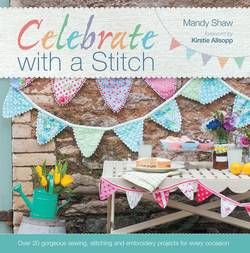Читать книгу Celebrate with a Stitch - Mandy Shaw - Страница 8
На сайте Литреса книга снята с продажи.
ОглавлениеWorking the Appliqué
Appliqué takes its name from the French verb appliquer, meaning to apply. The technique involves cutting fabric to shape and attaching it to a background fabric to create a surface decoration. The fabric shapes are held in position with fusible webbing and secured and embellished with hand or machine stitching.
Working with fusible webbing
Fusible webbing is an iron-on fabric adhesive that can be purchased in a roll or in pre-cut pieces and it looks like paper. One side is paper-backed and can be drawn on (so you can trace the motif you want) and the other has a thin membrane of glue that melts when heated by an iron to attach it to fabric. It is easy to use if you follow these simple step-by-step instructions.
1. Trace the motif you want onto the paper (smooth) side of the fusible webbing. Cut roughly around the drawn motif rather than following the drawn line accurately at this stage.
2. Iron the fusible webbing onto the wrong side of the appliqué fabric making sure that the fusible webbing is glue (rough) side down. The glue on the back of the fusible webbing melts when heated so be very careful to iron the paper side or else it will stick to your iron.
Tip
Always remember, the smooth side of the iron goes to the smooth side of the webbing.
3. Once the fusible webbing has been attached to the appliqué fabric you can cut out the motif accurately on the drawn line.
4. Carefully peel off the backing paper and position the appliqué motif onto the fabric it is to be applied to. Iron to fix in place.
5. Always cover the edge of the appliqué with a stitch to seal the edges. This can either be done by hand or by machine.
Many templates provided for the project appliqués are drawn in reverse (like the robin from the Christmas Pennant) so that they will be the right way round when you come to fuse and sew them.
Types of fusible webbing
There are several different types of fusible webbing on the market. Here is my guide to the brands you are most likely to encounter. Whichever you choose, always take the time to read the manufacturer’s instructions before using.
Bondaweb. A fine brand that sews through really well, but in storage the fusible film has a tendency to peel off the paper, so only buy sufficient for each project. A hot steam iron is used to fix the adhesive.
HeatnBond Lite. The adhesive film on this product is a little thicker than Bondaweb, so it stores really well. It fixes with a silk setting and if you use a hot iron by mistake it will render the adhesive useless, so take care.
Lite Steam-a-Seam 2. This product has the ability to stick your appliqué in place temporarily until you are ready to iron it, so no pieces of appliqué will come flying off on your journey to the iron.
Tips for Hand appliqué
• Use sharp fine scissors to cut out your appliqué shapes to give you a clean cut edge to sew over.
• Always use an appropriate needle for your thread – my personal favourite is John James embroidery size 7– and adapt the size of your stitch to the scale of the appliqué motif.
• If you prefer needle turned appliqué, add a 6mm (1⁄4in) seam allowance to the pieces, and use a fine matching thread and needle.
Before ironing the appliqué design in place, lay out the individual pieces to help you to establish the fusing order. For example, in the case of the birthday party table setting (Seven More Sleeps) the tablecloth is laid down first, then the cake is laid on top, and the braid for the cake band is added last.
Tips for machine appliqué
• Use a new needle: for best results use a sharp denim variety size 90/14 or 80/12, although for fine appliqué use a finer 70/10.
• Reduce your top tension a little – no bobbin thread should show on the top. Practise on identical fabric and layers first.
• Use bobbin fill or cotton thread in the bobbin; if there is a hole in the bobbin case arm, thread your cotton through it to improve tension.
• Use the machine’s needle-down facility to prevent stitches slipping.
• Use an open-toed embroidery/appliqué presser foot that has a cut-away on the underside to accommodate the raised appliqué.
• To start pull thread up to the top, sew a couple of stitches on top of each other, then cut the thread, to prevent threads tangling beneath.
• On curves, stop on the outside edge needle down, raise the presser foot and turn the fabric – stop and start as necessary.
If you overlap adjoining pieces of appliqué you will have only one edge to sew instead of two. For example, on the cupcake (Pennants) the case is tucked beneath the icing, so only the sides and the bottom edge of the cupcake case need to be sewn to secure it in place.
Tip
It is not always necessary to stitch a fusible appliqué down, for example if the work is not going to be laundered or if it will not be subject to a lot of wear. A quick make decorative pennant, such as the 21st birthday pennant, does not always require the appliqué to be stitched in place.
